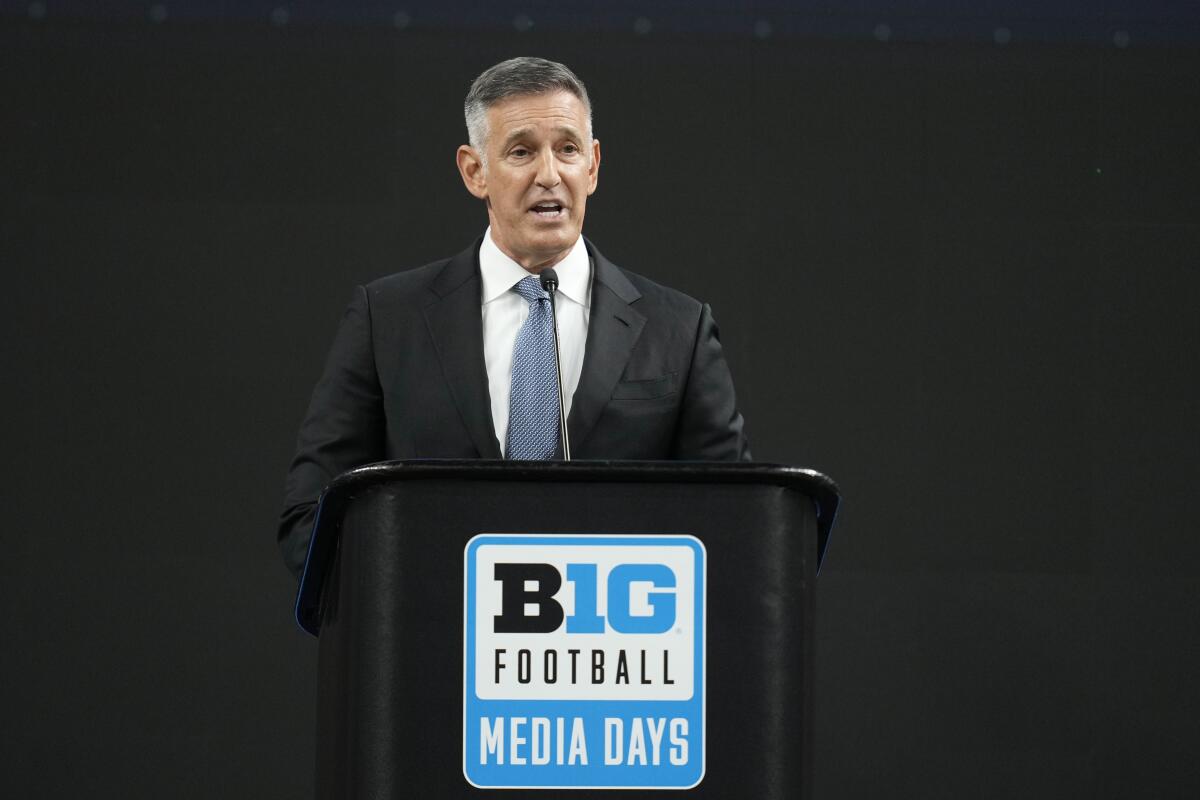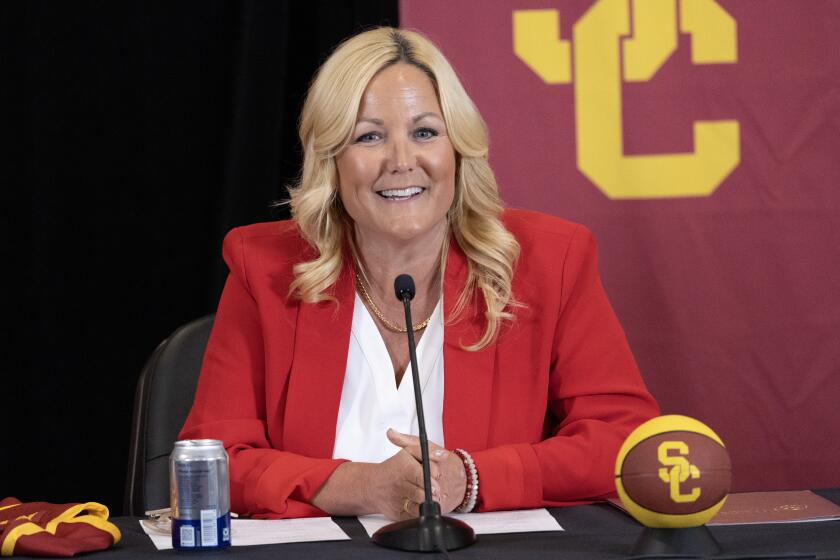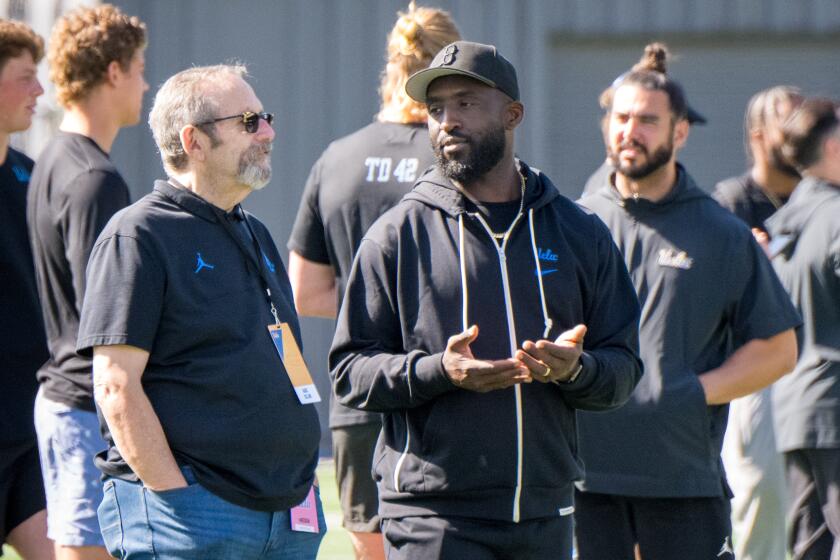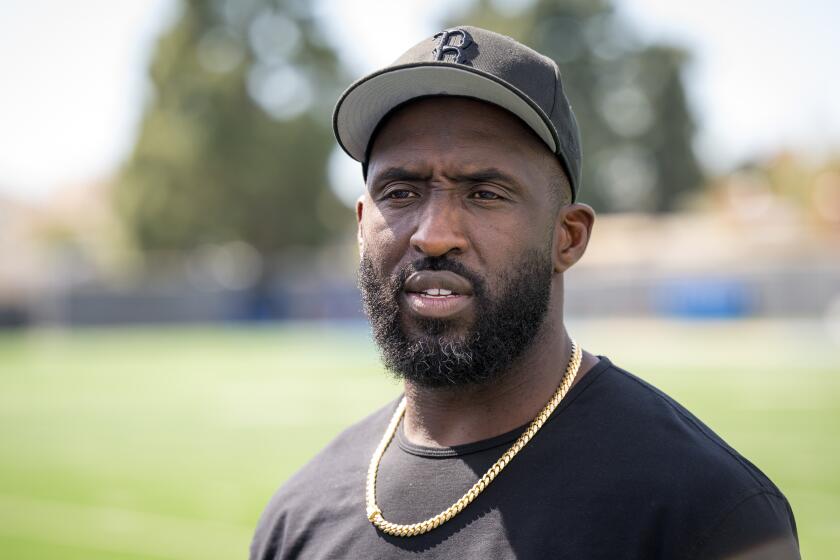Commissioner says he’s optimistic Big Ten ‘got a lot right’ with expansion

- Share via
INDIANAPOLIS — A giant, inflatable Oregon Duck mascot drifted down the White River on Tuesday, not far from where Big Ten Conference coaches, players and executives converged for the opening day of their annual media event.
It was not an interloper from some faraway place. It was home.
Adding to the surreal feel, mannequins wearing the football jerseys of Oregon, UCLA, USC and Washington with Big Ten patches on the shoulder stood in a corridor on the bottom level of Lucas Oil Stadium alongside those of traditional conference heavyweights Michigan, Ohio State and Penn State.
After welcoming the four new members who officially will join the conference Aug. 2, Big Ten commissioner Tony Petitti accepted a reporter’s invitation to daydream about stacking the expanded, 12-team College Football Playoff with entrants from his inflated, 18-team conference.
“I’m trying to think about what the maximum is,” Petitti told The Times while leaning back in a black leather chair deep inside the massive football stadium where the Big Ten championship game will be held in December.
In theory, the Big Ten could field eight CFP teams as part of a format that gives spots to five conference champions and the next seven highest-ranked teams. The chances of that happening might be on par with Petitti being the next man to walk on the moon, but that didn’t stop the commissioner from smiling about the possibility on a day dedicated to celebrating the completion of a merger two years in the making.
USC athletic director Jennifer Cohen is upbeat about the revenue-sharing model the university will ultimately adopt as it continues to lure top talent.
None of the newcomers were on hand — UCLA and USC players and coaches are scheduled to speak with the media Wednesday, followed by Oregon and Washington on Thursday — but the floating Duck introduced the longstanding conference members to some of their West Coast flair.
It was the latest marketing gimmick from the school that once trolled USC fans by erecting a billboard featuring three Oregon players on the side of a downtown Los Angeles hotel and posted another billboard of Heisman Trophy candidate Joey Harrington near Madison Square Garden, not far from the site of the award ceremony in New York.
Seeing the Duck floating outside his downtown Indianapolis office, NCAA president Charlie Baker forwarded a photo to Petitti, causing the commissioner to, well, quack up.
“I thought it was great,” Petitti said. “Like, this is supposed to be fun.”
After spending so many months solving logistical challenges posed by a coast-to-coast conference, Petitti said the coming weeks will celebrate the debut of the new Big Ten while trumpeting new rivalries, including several that involve historic Rose Bowl matchups.
That’s not to say that everything will be perfect, especially when it comes to scheduling. UCLA’s football team will travel a conference-high 22,048 miles this season, according to bookies.com, well ahead of second-place Washington’s 17,522, third-place USC’s 12,710 and fourth-place Oregon’s 12,520.
Even though a big chunk of the Bruins’ miles will be logged making nonconference trips to Hawaii and Louisiana State, there remains concern that the West Coast teams may face a competitive disadvantage given that they will pocket more sanitizing wipes while boarding flights than their Big Ten counterparts.
“We built the schedules in a way that we think could maximize competitive balance and try to ease the burden as best we can, understanding that there is going to be change and additional travel — you just can’t ignore that that’s going to be the case,” Petitti said. “Having said that, I think the other responsibility is to really learn from the first year or two about what’s working and what’s not, and I don’t want us to believe we got everything right right out of the gate — that’s not the way these things work — but I do know that we told all our coaching groups that we’re going to listen and get feedback and we’re going to look at what happens as we play out these schedules.
“Are there ways to do things better? How do we organize the postseason? What’s the best format for scheduling? And I’m very optimistic that we got a lot right and by definition there will probably be some changes down the road; you have to be open and honest about that.”
UCLA’s recruiting staff under new head coach DeShaun Foster has tripled in size and is embracing new strategies and techniques to attract talent.
While USC will play Rutgers at 8 p.m. Pacific time on Oct. 25 at the Coliseum as part of a Friday night Fox broadcast, Petitti said the West Coast teams can expect to play Saturday games with kickoffs often earlier than those to which they are accustomed.
“The windows and the exposure for the West Coast schools by playing in these time periods is going to help — I think they’ll be seen by more people in the current configuration that we have,” Petitti said. “There’s no doubt that the pattern we have will maximize audience for everybody, including West Coast schools.”
Petitti readily conceded that football might represent the least of his scheduling concerns given that it involved one game a week per school, not to mention teams used to extensive travel. The commissioner intimated there could be groupings for basketball that reduce the travel burden such as UCLA playing Indiana and Purdue on the same trip. The proposed neutral-site jamborees for Olympic sports remain in discussion but are not expected to be part of scheduling models for the upcoming season.
When it comes to expansion, 18 teams is enough … for the moment. Petitti said he wanted to focus on integrating the new schools into the conference while also preparing for the implications of the House v. NCAA settlement that is expected to rock college sports by paving the way for revenue sharing arrangements with athletes in addition to providing back pay for lost name, image and likeness deals. UCLA has said it expects to distribute at least $20 million a year to its athletes starting next year.
Unlike the Big 12 Conference, the Big Ten is not entertaining the possibility of a naming-rights deal, Petitti said, but the commissioner acknowledged that he was open to additional sponsorship opportunities that could increase revenue not just for schools but also athletes as part of the new world order in college athletics.
“The extent that we’re growing the revenue pot,” Petitti said, “it’s providing additional benefits to student-athletes because the pool that they’re taking advantage of is going to get bigger.”
After announcing that the Big Ten football championship game would be held in Indianapolis through 2028, Petitti said it was likely that the game would be moved to other locations in future years given the conference’s expanded footprint. (Las Vegas? Are you listening?)
As part of an introductory tour, the commissioner said he expected to attend at least one football home game of each of the four new West Coast members this fall. His stop in Los Angeles will come with the bonus of visiting the daughter who is a USC graduate.
When he gets to Oregon, who knows what sort of surprise the Ducks might have in store.
More to Read
Go beyond the scoreboard
Get the latest on L.A.'s teams in the daily Sports Report newsletter.
You may occasionally receive promotional content from the Los Angeles Times.









